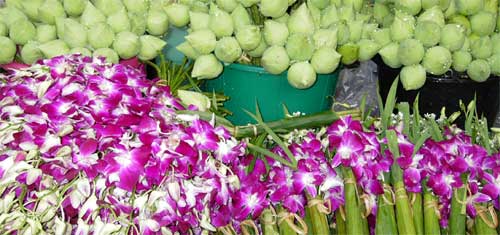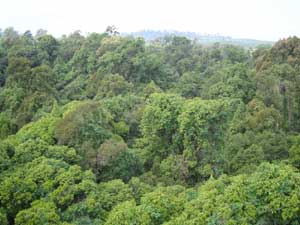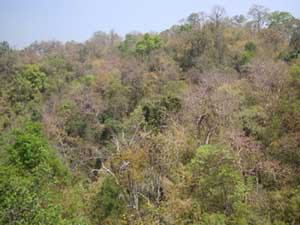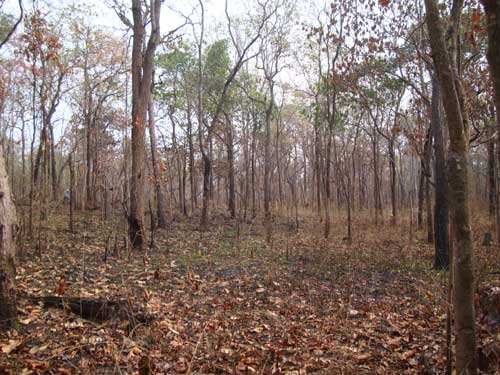

Most of Thailand is classified under Köppen system as a tropical monsoon climate (Aw), with high total rainfall, distinct wet and dry seasons, and the driest month having a mean precipitation of less than 6 mm. In Thailand, there is a distinct dry season of over 4-5 month(November to March). Various forest types are found in lowland (< 1000 m) Thailand. The mean annual air temperature is approximately 27˚C and the annual precipitation is approximately 1600 mm, respectively. Regardless of similar air temperature, similar annual precipitation, and similar seasonality of rainfall, there are evergreen and dry-deciduous forests in lowland Thailand. Thus the variation of soil type is likely to be an important factor to decide on forest types. Nevertheless, the forest fire frequently occurs in the deciduous forests during the dry season. Thus many other factors, such as historical human impact and forest fire, are no doubt involved as well.
Geologically, the western part of Thailand is influenced by fold due to the plate tectonic story attributed to Himarayan orogen; Indian plate has subducted under Eurasian plate. Because of the fold, Mesozonic limestone areas are frequently found. Tributaries in the western part are branches of the Chao Phraya River or Khwae Noi River et al. On the other hand, the eastern part of Thailand is uninfluenced by any fold. The origin of base rock is of Gondowana land, the oldest basement of the world. Tributaries in the eastern part are branches of the Maekong River.
 The
photograph was taken at the Sakaerat Environmental Research Station (14˚29’
N and 101˚55’
E, 563 m a.s.l.) about 180 km northeast of Bangkok. The soil is of
sandstone origin and acidic (pH of around 4.5), and the soil was thick,
but the soil nutrients are poor. A little evergreen dipterocarp
species, Hopea
ferrea
and Shorea
henreyana,
are predominant in DEF. The maximum tree heights over 30 m high.
Nevertheless, we could find 46 woody plant species at DEF in the
Sakaerat Environmental Research Station. Even in the dry season, forest
fires do not break out in DEF.
The
photograph was taken at the Sakaerat Environmental Research Station (14˚29’
N and 101˚55’
E, 563 m a.s.l.) about 180 km northeast of Bangkok. The soil is of
sandstone origin and acidic (pH of around 4.5), and the soil was thick,
but the soil nutrients are poor. A little evergreen dipterocarp
species, Hopea
ferrea
and Shorea
henreyana,
are predominant in DEF. The maximum tree heights over 30 m high.
Nevertheless, we could find 46 woody plant species at DEF in the
Sakaerat Environmental Research Station. Even in the dry season, forest
fires do not break out in DEF. The
photograph was taken during the dry season (February) at the
Mae-Klong Watershed Research Station (14˚34’
N and 98˚50’
E, 160 m a.s.l.) about 250 km northwest of Bangkok. The soil is of
limestone origin and relatively eutrophic, and the soil pH is closed
to neutral (6.5). The distribution of MDF in Thailand looks like to
well be consistent with the limestome area. Many tree species are
found in MDF. We could find 157 woody plant species at MDF in
Mae-Klong Watershed Research Station. The maximum tree heights reach
25 m high. Almost all species are deciduous trees, but dipterocarps
are rare. Tectona
(teak) is a typical tree species in MDF, and bamboos with crowded
shoots are well found in MDF. Forest fires frequently break out during
the dry season. The leaf-shed period during the dry season largely
varies among tree species. Many trees can start their leaf flushing
during the driest season (February). Thus we can simultaneously look
trees with new-flushing leaves, trees with no leaves, and trees with
old leaves during the dry season (see the attached photograph).
The
photograph was taken during the dry season (February) at the
Mae-Klong Watershed Research Station (14˚34’
N and 98˚50’
E, 160 m a.s.l.) about 250 km northwest of Bangkok. The soil is of
limestone origin and relatively eutrophic, and the soil pH is closed
to neutral (6.5). The distribution of MDF in Thailand looks like to
well be consistent with the limestome area. Many tree species are
found in MDF. We could find 157 woody plant species at MDF in
Mae-Klong Watershed Research Station. The maximum tree heights reach
25 m high. Almost all species are deciduous trees, but dipterocarps
are rare. Tectona
(teak) is a typical tree species in MDF, and bamboos with crowded
shoots are well found in MDF. Forest fires frequently break out during
the dry season. The leaf-shed period during the dry season largely
varies among tree species. Many trees can start their leaf flushing
during the driest season (February). Thus we can simultaneously look
trees with new-flushing leaves, trees with no leaves, and trees with
old leaves during the dry season (see the attached photograph).
The photograph was taken in the dry season at the Sakaerat Environmental Research Station. The soil is of sandstone origin and acidic (pH of around 4.5). Bedrocks are frequently found, the sandy soil is thin, and the soil nutrients are poor. Several dipterocarps, Shorea siamensis, Shorea obtusa, Shorea roxburbii, and Dipterocarpus intricatus, are predominant in DDF. Their maximum tree heights are less than 10 m high. Nevertheless, we could find 49 woody plant species at DDF in the Sakaerat Environmental Research Station. During the dry season, forest fires frequently break out in DDF. Despite of the thin soil, many trees can start their leaf flushing during the dry season.

We hypothesized that soil types are dependent on forest types, and forest types are dependent on forest function in seasonally dry tropical forests in Southeast Asia. We have constructed scaffolding towers to access the top canopies, and conducted a long-term monitoring of microclimate, canopy gas flux, leaf phenology, leaf gas exchange, photo-inhibition tolerance in leaves, and plant water relations.We have sometimes used a crane car to access the top canopy leaves as well. In especially, severe drought arrises during the dry season. Because leaf gas exchange reduce during the dry season, danger of photo-inhibiton also increases in the sunlit canopy leaves. Thus the comparison in water relations and photo-inhibition tolerance between the drought-deciduous and evergreen trees is one of main research topics.
In soil, we have investigated the chemical and physical properties and the seasonal variations of soil respiration rates. In forest dynamics, we have set fixed plots and have periodically measured tree growth and death in the plots. To know the functional diversity of woody plants, we have examined leaf anatomy and physiology in as many tree species as possible in each forest type. Throughout the broad array of these measurements, we clarify forest function and ecological services, such as carbon stock and biodiversity, in the seasonaly dry tropical forests in Thailand.
Tropical forests raise many livings and give us many ecological services. However, the area of tropical forests is rapidly decreasing in the world. We have clarified the tight correlations among soil, plants, and microclimate in the seasonally tropical dry forests. Because of the tight correlations, global climate change or land-use change will disturb the tight correlations and will bring the degradation of forest ecosystem. As the results, only not quantity also quality of ecological survice provided by the tropical forests will extremely deteriorate. In order to conserve the valuable forests, we have investigated the origin and function of each forest type.
